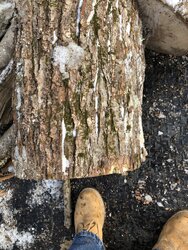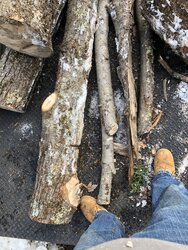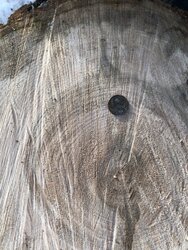Maple ID
- Thread starter Enplater
- Start date
-
Active since 1995, Hearth.com is THE place on the internet for free information and advice about wood stoves, pellet stoves and other energy saving equipment.
We strive to provide opinions, articles, discussions and history related to Hearth Products and in a more general sense, energy issues.
We promote the EFFICIENT, RESPONSIBLE, CLEAN and SAFE use of all fuels, whether renewable or fossil.
You are using an out of date browser. It may not display this or other websites correctly.
You should upgrade or use an alternative browser.
You should upgrade or use an alternative browser.
woodhounder
Member
peakbagger
Minister of Fire
Red maple is decent I guess, not bad for free. I think I am burning some oak and soft maple in the stove now which has good results but shorter burn times. Next year will be good, I have a big pile of mostly black locust and black birch, another big pile of red oak and about 2 cords of soft maple/black cherry(I think), oh yeah another pile of red oak. Never enough I guess.
peakbagger
Minister of Fire
Also, is soft maple anything that’s not sugar maple or is it a specific tree?
https://www.wood-database.com/wood-articles/differences-between-hard-maple-and-soft-maple/
I find that red maple is preferable to silver maple. Of course different growing conditions will yield big differences across a specific variety of any tree. A tree that has grown up in dense woods is going to have tighter grain than one that is in more open woods or fields. The end grain picture shows a fairly tight grain so it should end up being dense. The branch wood shown is going to be looser and less dense. So a red maple that grows in after a clear cut can have wider looser rings than a silver maple that grew under a well developed canopy. Tight grain generally means denser wood and that means when its seasoned, a longer burn. Note in urban areas Norway maples are considered invasive and they tend to be the urban maple as they were planted extensively as they are tolerant to city conditions including road salt. Norway's are considered to be about equal to silver maples.
Its going to be rare to see sugar maple naturally regenerating in areas of NH that have been farmed and even up in the mountains they are far less prevalent than in VT. In order for the sugar maples to reproduce from seed they need a deep layer of organic matter on the forest floor (AKA duff). Earthworms which were reintroduced into the region after the last ice age rapidly turn the leaf layer into castings so the duff is lot thinner.Once the area is farmed the worms move in and never leave. Hard maple also prefers "sweeter soil" that is more prevalent in VT than in NH. Red maples are more tolerant to soil conditions so they tend to move in where hard maples were in borderline conditions. I think there is global warming aspect but not sure of the mechanism but it could be as simple as hard maples like cooler conditions. I think acid rain was a bad actor as it leached out soil minerals and made it less "sweet" but luckily, acid rain is no longer a major issue in the northeast as most of the atmospheric sources like midwest coal plants have either closed or installed scrubbers.
If a sugar maple seedling is planted in thin duff it will grow although other more tolerant varieties will try to move in and may not thrive unless the soil is amended. Norway's are very aggressive, if they find a crack in pavement they will try to grow an put out of copious amounts of seeds every year. Reds also tend to move in after clear cuts an fight it out with the ash, birch and cherry but frequently win out. Red also tolerate wet soil, you will frequent see them growing in clumps on edges of wetlands. They frequently will stay in clumps and eventually water will get in between the trees and rot out the base of all the trees. Best thing to do in long term is prune the clumps so that one healthy tree remains per clump. The tough part is you need good chainsaw control as you do not want to scar the remaining trees bark when removing the others.
Ultimately you burn what you got. If you have a choice, hard maple is better than red but red maple is going to typically season quicker. If you are in southern or central NH oak is going to be on par with hard maple although typically oak takes longer to season. Up my way in northern NH (roughly north of RT2) the oaks taper off but are starting to creep back due to a warmer climate. The choice woods in my area if you have the time to season are beech, yellow birch and hard maple. White birch, ash and cherry can season quick but less dense meaning burning quicker. The definitely least desirable species is generally called poplar which is mix of aspen varieties. Generally its regarded as trash wood by the locals and when buying firewood you should specify no poplar as its mostly water so when its seasoned it burns quick and doesn't put out much heat, it also rots quick Unscrupulous dealers will mix it in with other hardwoods to stretch their supplies and sell it to unknowing buyers usually when folks are desperate for dry wood.
I have a boiler with storage so I want a fast burn so I am far less concerned with dense wood. Someone with wood stove who wants all night burns is going to want denser wood.
Kevin Weis
Minister of Fire
Silver Maple burns but be prepared for the ash accumulation and short burn times. Red Maple a hair better maybe. Especially if you use just the heart wood (darker wood) from it.
Your right peak, I haven’t seen much sugar maple. Out behind my house there is a sap collection operation with miles of tubing and a collection tote, then gets pumped to the road with an electric pump. Im guessing there are sugar maples out there. But every maple on my property has jagged leaves, too bad I wish they were a better species but the guy I got the maple from said he had a lot of beech that’s dead and another red oak so this will be a good haul this spring.
peakbagger
Minister of Fire
Folks forget that around the civil war Me, NH and VT were the farm supplier to southern New England, add in the demand for wool for the textile mills and any flat land that could be farmed were farmed. Many of those farms grew back up into woods but they didn't come back in sugar maple.
You can still tap red maple, the sugar content is lower but it still makes syrup. Now that reverse osmosis system made it easy to take out the excess water out of the sap, sugar content is less of issue. Not sure if anyone is intentionally tapping red maple stands but expect if they have some reds mixed in with the sugar maples they probably tap them. Heck some tapping operations are taking the water they remove from the sap bottling it and selling it as some magic health potion.
Note beech can be a bear to split and you need to be careful on the beech, light scarring on the bark from the blight is fine but if the bark is full of marble sized cavities which is the end stage of the blight you want to get it split and stacked undercover as those cavities are going to encourage rot. It takes a lot to kill them so if they are standing dead they may be past firewood stage. I have about 80 acres that need to be thinned of beech, almost all the trees have some blight but still in good shape but in some areas of small beeches that regenerated from the root systems the amount of salvageable wood is darn close to zero.
You can still tap red maple, the sugar content is lower but it still makes syrup. Now that reverse osmosis system made it easy to take out the excess water out of the sap, sugar content is less of issue. Not sure if anyone is intentionally tapping red maple stands but expect if they have some reds mixed in with the sugar maples they probably tap them. Heck some tapping operations are taking the water they remove from the sap bottling it and selling it as some magic health potion.
Note beech can be a bear to split and you need to be careful on the beech, light scarring on the bark from the blight is fine but if the bark is full of marble sized cavities which is the end stage of the blight you want to get it split and stacked undercover as those cavities are going to encourage rot. It takes a lot to kill them so if they are standing dead they may be past firewood stage. I have about 80 acres that need to be thinned of beech, almost all the trees have some blight but still in good shape but in some areas of small beeches that regenerated from the root systems the amount of salvageable wood is darn close to zero.
Magic health potion...nice! Lol. Last fall I actually found a small electric splitter for $100 used so any trouble makers will go through that, the rest gets split with a fiskers splitting axe. I had never heard of blight until now, good to know.
Look at this big beech (I think) I found in east Kingston.

Look at this big beech (I think) I found in east Kingston.

Similar threads
- Replies
- 20
- Views
- 2K
- Replies
- 19
- Views
- 2K




